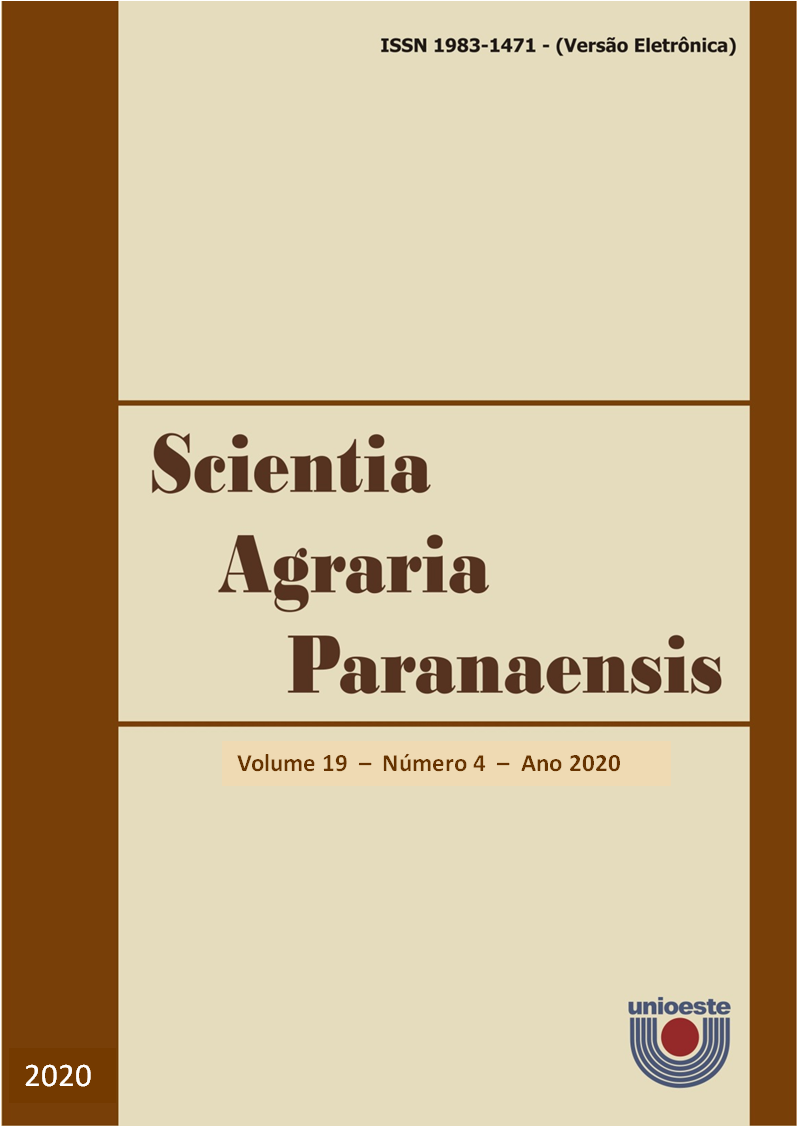Correlation and path analysis in wheat cultivars in the initial period of development
DOI:
https://doi.org/10.18188/sap.v19i4.25270
Agências de fomento
PIBIC, PROBIC e Fipe Jr.
Resumo
The cultivation of soybeans in the central region of the state of Rio Grande do Sul, has increased the interest of farmers for winter crops in the region. However, information related to crop development in a low-latitude environment is limited and necessary to improve crop management. The objectives of this article were to evaluate the linear relation between traits of spring wheat cultivars in the initial period of development in a low-altitude site. The experiments were conducted in two years in Santa Maria - RS. The experimental design used was randomized blocks, with ten wheat cultivars. The evaluations were carried out at the end of the tillering, where 300 plants were selected per year, obtaining a total sample number of 600 plants. After selecting, the character’s plant height (PH), the number of leaves of the main stem (NLMS), the number of leaves per plant (NLP), the number of tillers (NT), and the dry matter (DM) were measured. Pearson’s correlation coefficient matrices were estimated, and the path analysis of the main variable DM was performed as a function of PH, NLMS, NLP, NT, and DM. The cultivars TBIO Mestre and TBIO Sinuelo have a higher number of tillers. The NLP has a greater direct effect on DM, in field conditions it is recommended to count the NT, as it has a direct relationship with DM and NLP, associated with this, the character is fast to count and has agronomic value for the wheat crop. In a low-altitude cultivation site, the number of tillers depends on cultivation and environmental conditions. The cultivars TBIO Mestre and TBIO Sinuelo have high tillering capacity. Based on linear relationships, through the non-destructive selection of wheat plants with a greater number of leaves per plant and a greater number of tillers, plants with a higher dry matter mass are indirectly selected. However, the number of tillers is recommended because it is quick to measure.
Downloads
Publicado
30-03-2021
Como Citar
FOLLMANN, D. N.; ROSSATO, R. M.; FREIBERG, C. M.; LEMAINSKI, L. E.; NIED, A. H.; FILHO, A. C. Correlation and path analysis in wheat cultivars in the initial period of development. Scientia Agraria Paranaensis, [S. l.], v. 19, n. 4, p. 386–394, 2021. DOI: 10.18188/sap.v19i4.25270. Disponível em: https://e-revista.unioeste.br/index.php/scientiaagraria/article/view/25270. Acesso em: 26 jul. 2025.
Edição
Seção
Artigos Científicos
Licença
Aviso de Direito Autoral Creative Commons
Política para Periódicos de Acesso Livre
Autores que publicam nesta revista concordam com os seguintes termos:
1. Autores mantém os direitos autorais e concedem à revista o direito de primeira publicação, com o trabalho simultaneamente licenciado sob a Licença Creative Commons Attribution que permite o compartilhamento do trabalho com reconhecimento da autoria e publicação inicial nesta revista.2. Autores têm autorização para assumir contratos adicionais separadamente, para distribuição não-exclusiva da versão do trabalho publicada nesta revista (ex.: publicar em repositório institucional ou como capítulo de livro), com reconhecimento de autoria e publicação inicial nesta revista.
3. Autores têm permissão e são estimulados a publicar e distribuir seu trabalho online (ex.: em repositórios institucionais ou na sua página pessoal) a qualquer ponto antes ou durante o processo editorial, já que isso pode gerar alterações produtivas, bem como aumentar o impacto e a citação do trabalho publicado (Veja O Efeito do Acesso Livre).
Licença Creative Commons
Esta obra está licenciada com uma Licença Creative Commons Atribuição-NãoComercial-CompartilhaIgual 4.0 Internacional, o que permite compartilhar, copiar, distribuir, exibir, reproduzir, a totalidade ou partes desde que não tenha objetivo comercial e sejam citados os autores e a fonte.


